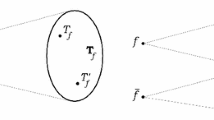Summary
The requirement of linearity between forces and accelerations leads to a unique given form for the Lagrangian density, which is also useful to construct nonlinear gravitational theories with distributed matter. Taking into account the two constraints i) dx αdx α=ds 2 and ii) the continuity equation, we obtain a unique (vector) variational equation which generalizes the Khalatnikov-Infeld equation which takes into account the constraint i) only (and in turn generalizes the Euler-Lagrange equation). In this way we obtain the usual (vector) equation of motion of perfect fluids with no ambiguity. Besides we reconfirm the validity of this equation in spite of recent criticisms.
Riassunto
Il requisito di linearità tra forze e accelerazioni determina univocamente una forma per la densità lagrangiana, che è anche utile al fine di costruire teorie gravitazionali non lineari per materia distribuita. Tenendo conto dei due vincoli i) dx αdx α=ds 2 e ii) l’equazione di continuità, otteniamo univocamente un’equazione vettoriale che risolve il problema variazionale generalizzando l’equazione di Khalatnikov-Kalman la quale tiene conto solo del primo vincolo (e a sua volta generalizza l’equazione di Eulero-Lagrange). In tal modo otteniamo senza ambiguità le comuni equazioni di moto che sono state di recente criticate.
Резюме
Требование линейности между силами и ускорениями приводит к заданной форме для плотности Лагранжиана, которая оказывается полезной также для конструирования нелинейных гравитационных теорий с распределенным веществом. Учитывая два ограничения: i) dx αdx α=ds 2 и ii) уравнение непрерывности, мы получаем единственное (векторное) вариационное уравнение, которое обобщает уравнение Халатникова-Инфельда, которое учитывает только первое ограничение (и, в свою очередь, обобщает уравнения Эйлера-Лагранжа). Таким образом, мы получаем обычное (векторное) уравнение движения для идеальных Зидкостей без каких-либо неоднозначностей. Кроме того, мы заново подтверждаем справедливость этого уравнения, после недавней критики Арзелиса и Каттанео.
Similar content being viewed by others
References
G. Cavalleri andG. Spinelli:Lett. Nuovo Cimento,9, 325 (1974).
G. Cavalleri andG. Spinelli:Nuovo Cimento,21 B, 1, 27 (1974).
A. Lichnerowicz:Théories relativistes de la gravitation et de l'électromagnétisme (Paris, 1955), p. 74 and 101.
I. M. Khalatnikov:Žurn. Ėksp. Teor. Fiz.,27, 529 (1954).
Z. Koba:Progr. Theor. Phys.,14, 488 (1955).
A. H. Taub:Phys. Rev.,94, 1468 (1954); see alsoA. H. Taub: inProceedings of C.I.M.E., Course «Relativistic Fluid Dynamics», edited byC. Cattaneo (Bressanone, 1970).
B. F. Schutz jr.:Phys. Rev. D,2, 2762 (1970).
J. R. Ray:Journ. Math. Phys.,13, 1451 (1970).
After ref. (1). eq. (2) has been obtained byL. Infeld (Bull. Acad. Polon. Sci., Cl. III,5, 491 (1957)A. Trautman (Bull. Acad. Polon. Sci., Cl. III,5, 721 (1957)).G. Kalman (Phys. Rev.,123, 384 (1961))
See ref. (1).
G. M. Prosperi:Rend. Acc. Naz. Lincei,18, 69 (1955)). See alsoP. Caldirola:Teoria quantistica relativistica (Milano, 1960), p. 13.
SC. Møller:The Theory of Relativity, Sect.67 (Oxford, 1952).
C. Cattaneo:Rend. Acc. Naz. Lincei,46, 698 (1969).
H. Arzeliès:Compt. Rend.,270 A, 347 (1970).
G. Cavalleri:Nuovo Cimento,53 B, 415 (1968).
C. Cattaneo:Boll. Unione Mat. Ital,80, 52 (1973).
A. Einstein:The Meaning of Relativity (Princeton, N. J., 1950), p. 53.
G. Cavalleri andG. Salgarelli:Nuovo Cimento,62 A, 722 (1969).
ref. (18).S. Aranoff (Nuovo Cimento,10 B, 155 (1972);Amer. Journ. Phys.,41, 1108 (1974)),Ø. Grøn (Nuovo Cimento,17 B, 141 (1973)),S. Pahor andJ. Strnad (Nuovo Cimento,20 B, 105 (1974)),G. Cavalleri, G. Spaveri andG. Spinelli (Nuovo Cimento,25 B, 348 (1975)).
G. Cavalleri andG. Spinelli:Nuovo Cimento,66 B, 11 (1970).
Author information
Authors and Affiliations
Additional information
Переведено редакцией.
Rights and permissions
About this article
Cite this article
Cavalleri, G., Spinelli, G. Lagrangian for perfect fluids in special relativity. Nuov Cim B 25, 357–366 (1975). https://doi.org/10.1007/BF02737686
Received:
Published:
Issue Date:
DOI: https://doi.org/10.1007/BF02737686



